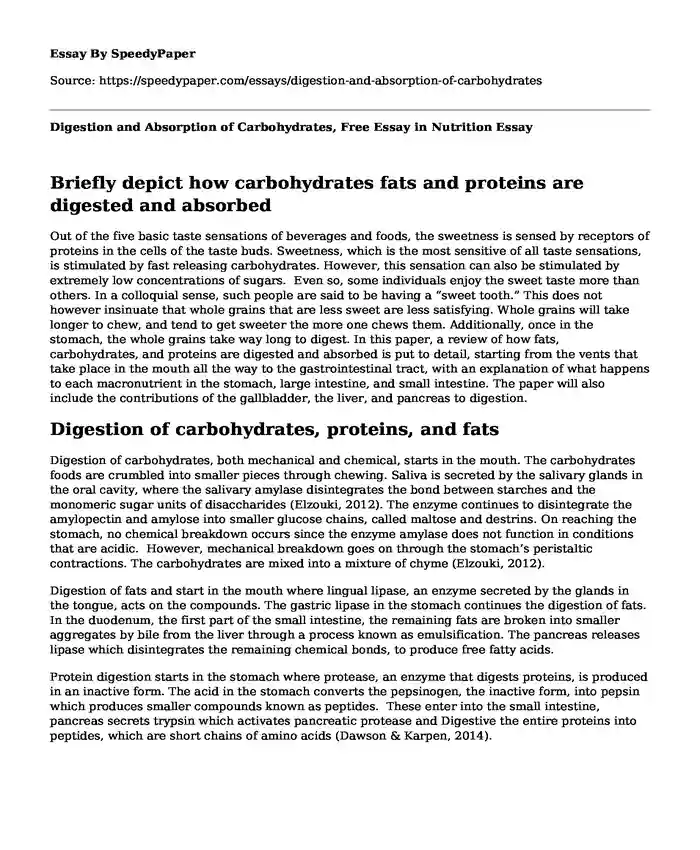
| Type of paper: | Essay |
| Categories: | Health and Social Care Food Nutrition |
| Pages: | 3 |
| Wordcount: | 799 words |
Briefly depict how carbohydrates fats and proteins are digested and absorbed
Out of the five basic taste sensations of beverages and foods, the sweetness is sensed by receptors of proteins in the cells of the taste buds. Sweetness, which is the most sensitive of all taste sensations, is stimulated by fast releasing carbohydrates. However, this sensation can also be stimulated by extremely low concentrations of sugars. Even so, some individuals enjoy the sweet taste more than others. In a colloquial sense, such people are said to be having a “sweet tooth.” This does not however insinuate that whole grains that are less sweet are less satisfying. Whole grains will take longer to chew, and tend to get sweeter the more one chews them. Additionally, once in the stomach, the whole grains take way long to digest. In this paper, a review of how fats, carbohydrates, and proteins are digested and absorbed is put to detail, starting from the vents that take place in the mouth all the way to the gastrointestinal tract, with an explanation of what happens to each macronutrient in the stomach, large intestine, and small intestine. The paper will also include the contributions of the gallbladder, the liver, and pancreas to digestion.
Digestion of carbohydrates, proteins, and fats
Digestion of carbohydrates, both mechanical and chemical, starts in the mouth. The carbohydrates foods are crumbled into smaller pieces through chewing. Saliva is secreted by the salivary glands in the oral cavity, where the salivary amylase disintegrates the bond between starches and the monomeric sugar units of disaccharides (Elzouki, 2012). The enzyme continues to disintegrate the amylopectin and amylose into smaller glucose chains, called maltose and destrins. On reaching the stomach, no chemical breakdown occurs since the enzyme amylase does not function in conditions that are acidic. However, mechanical breakdown goes on through the stomach’s peristaltic contractions. The carbohydrates are mixed into a mixture of chyme (Elzouki, 2012).
Digestion of fats and start in the mouth where lingual lipase, an enzyme secreted by the glands in the tongue, acts on the compounds. The gastric lipase in the stomach continues the digestion of fats. In the duodenum, the first part of the small intestine, the remaining fats are broken into smaller aggregates by bile from the liver through a process known as emulsification. The pancreas releases lipase which disintegrates the remaining chemical bonds, to produce free fatty acids.
Protein digestion starts in the stomach where protease, an enzyme that digests proteins, is produced in an inactive form. The acid in the stomach converts the pepsinogen, the inactive form, into pepsin which produces smaller compounds known as peptides. These enter into the small intestine, pancreas secrets trypsin which activates pancreatic protease and Digestive the entire proteins into peptides, which are short chains of amino acids (Dawson & Karpen, 2014).
Absorption of carbohydrates, proteins, and fats
The chyme is expelled into the small intestine’s upper part. Here, the pancreatic juice is released by the pancreas, which contains the pancreatic amylase enzyme. This enzyme breaks down dextrins into shorter chains of carbohydrates. Additionally, intestinal cells that line the villi secretes enzymes, namely, sucrose, disaccharides, lactase and maltase. The enzyme sucrase disintegrates sucrose into and sucrose molecules.. When the chemical break down of carbohydrates into single sugar units is completed, they are transported inside the intestinal walls.
The cells of the small intestines have membranes that transport proteins that take monosaccharides into the blood. The first organ to recieve glucose, fructose, and galactose is the liver. In the liver, galactse is converted to glucose, breaking fructose into smaller units of carbon. The liver exports it to the blood.
The amino acids from both fats and proteins are move through the membranes of the microvilli in the small intestines. Once inside, the amino acids pass through cells to reach its lower portion and into the blood (Mansbach, Tso & Kuksis, 2011).
Some of the carbohydrates that have not been digested are broken down by enzymes released in the large intestine. The products which are a result of the bacterial digestion in the colon are some gases and short-chain fatty acids (Elzouki, 2012). The fatty acids are either absorbed in the colon’s cells with some being transported in the liver, used by the bacteria to make energy, or eliminated in the feces.
References
Dawson, P. & Karpen, S. (2014). Intestinal transport and metabolism of bile acids. J. Lipid Res., 56(6), 1085-1099. http://dx.doi.org/10.1194/jlr.r054114
Elbeshbishy, E. & Nakhla, G. (2012). Batch anaerobic co-digestion of proteins and carbohydrates. Bioresource Technology, 116, 170-178. http://dx.doi.org/10.1016/j.biortech.2012.04.052
Nichols, C. & Cukras, C. (2001). KATP Channel Regulators: Balanced Diets Include Carbohydrates, Proteins, and Fats. Circulation Research, 88(9), 849-851. http://dx.doi.org/10.1161/hh0901.091206
Cite this page
Digestion and Absorption of Carbohydrates, Free Essay in Nutrition. (2017, Oct 13). Retrieved from https://speedypaper.net/essays/digestion-and-absorption-of-carbohydrates
Request Removal
If you are the original author of this essay and no longer wish to have it published on the SpeedyPaper website, please click below to request its removal:
- Free Essay on Buying a New Car
- Free Essay Sample on Why Is Evolution False
- Essay Sample on the Roles of a School Principal
- Ethics Code - HRM Essay Example
- Essay Example on Interview With a Pregnant Lady: Experience of Giving a Birth
- Critical Essay on Controversial Advertisement: Make Peace Not War
- Free Essay Example on COVID-19 Impact on International Business: Scenarios Unveiled
Popular categories




